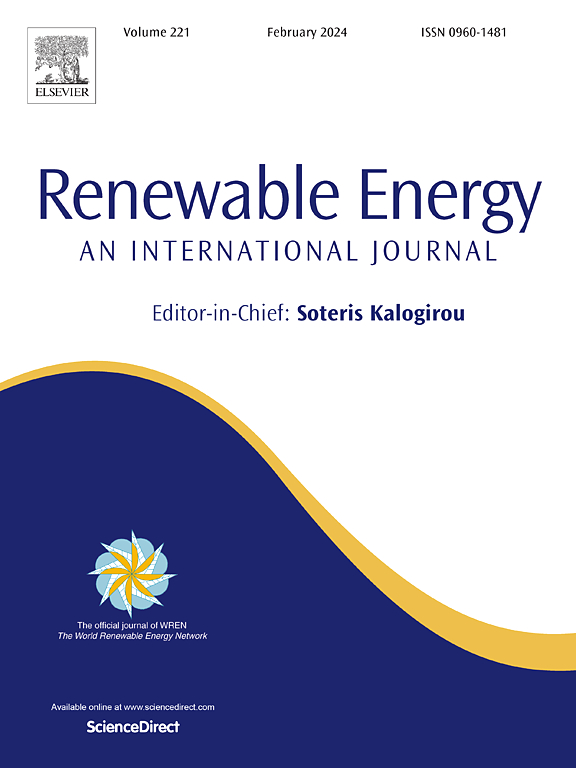Performance evaluation of different photovoltaic array configurations under partial shading
IF 9
1区 工程技术
Q1 ENERGY & FUELS
引用次数: 0
Abstract
In Partial Shading Conditions (PSCs), Photo Voltaic (PV) systems often experience notable output power and efficiency reductions due to weather variations. This study is dedicated to determining the most effective PV array configuration under partial shading. Various configurations, including Series Parallel (SP), Total Cross Tied (TCT), Bridge Linked (BL), Honey Comb (HC), Double Tied (DT), and hybrid connections, are simulated and evaluated under PSCs. Nine shading patterns, such as vertical, horizontal, centre-wise, upper triangular, cross-wise, expansive, arbitrary, L-shaped, and diagonal, are examined using a 6 × 6 array of PV Configuration. Performance analysis is based on parameters such as open circuit voltage (Voc), short circuit current (Isc), Global Maximum Power Point (GMPP), maximum voltage (Vm), maximum current (Im), Fill Factor (FF), Mismatch Loss (ML)/Power Loss (PL), and efficiency (η). Additionally, hybrid configurations like Alternate- Total Cross Tied -Bridge Linked (ALT-TCT-BL), Alternate -Total Cross Tied -Double Tied (ALT-TCT-DT), and Alternate -Total Cross Tied -Triple Tied (ALT-TCT-TT) are investigated and compared with existing configurations. Hybrid configurations with fewer cross-ties are recommended to simplify circuit complexity. MATLAB/Simulink software is employed for simulation, using a Sunpower SPR-E18-295-COM panel. Comparative analysis confirms that hybrid configurations exhibit higher efficiency for various shading patterns than existing configurations, equal or at par with the TCT connection. For eight connections and nine shading scenarios along with zero (no) shading conditions, eighty distinct combinations have been analysed, and on comparative analysis with contemporary work, the optimal output is obtained from the connections considered under PSCs. For all the shading patterns considered, the proposed work fetches maximum efficiency compared to the contemporary work, and it ranges between 13.61 % and 17.84 % for different shading patterns. The maximum value of efficiencies for horizontal, vertical, diagonal, centre-wise, expansive, arbitrary, upper triangular and L-shaped shading patterns is 13.77 %, 17.24 %, 17.84 %, 15.66 %, 13.61 %, 17.21 %,17.35 % and 15.11 % respectively. The hybrid configuration achieves higher efficiency than current methods for all shading patterns and configurations, with improvements in efficiency ranging from 2.1 % to 42.22 % across all cases.
部分遮阳条件下不同光伏阵列配置的性能评估
在部分遮阳条件(PSCs)下,光伏(PV)系统的输出功率和效率往往会因天气变化而明显下降。本研究致力于确定部分遮阳条件下最有效的光伏阵列配置。在 PSCs 下,模拟并评估了各种配置,包括串并联 (SP)、全交叉连接 (TCT)、桥联接 (BL)、蜜蜂梳 (HC)、双联 (DT) 和混合连接。使用 6 × 6 光伏配置阵列对九种遮阳模式进行了研究,如垂直、水平、中心向、上三角、十字向、扩张、任意、L 形和对角线。性能分析基于开路电压 (Voc)、短路电流 (Isc)、全局最大功率点 (GMPP)、最大电压 (Vm)、最大电流 (Im)、填充因子 (FF)、失配损失 (ML)/ 功率损失 (PL) 和效率 (η)等参数。此外,还对混合配置进行了研究,并与现有配置进行了比较,如交替-总交叉绑定-桥接(ALT-TCT-BL)、交替-总交叉绑定-双绑定(ALT-TCT-DT)和交替-总交叉绑定-三绑定(ALT-TCT-TT)。建议采用交叉连接较少的混合配置,以简化电路的复杂性。仿真采用 MATLAB/Simulink 软件,使用 Sunpower SPR-E18-295-COM 面板。对比分析证实,在各种遮阳模式下,混合配置的效率高于现有配置,与 TCT 连接相当或相当。针对八种连接方式和九种遮阳情况以及零(无)遮阳条件,分析了八十种不同的组合,并与当代研究成果进行了比较分析,结果表明,在 PSCs 下考虑的连接方式可获得最佳输出。在考虑的所有遮阳模式中,与现代技术相比,建议的技术都能获得最高效率,不同遮阳模式的效率介于 13.61 % 和 17.84 % 之间。水平、垂直、对角、中心、扩张、任意、上三角和 L 形遮阳模式的最高效率值分别为 13.77 %、17.24 %、17.84 %、15.66 %、13.61 %、17.21 %、17.35 % 和 15.11 %。在所有遮阳模式和配置下,混合配置的效率都高于现有方法,在所有情况下,效率提高了 2.1 % 至 42.22 %。
本文章由计算机程序翻译,如有差异,请以英文原文为准。
求助全文
约1分钟内获得全文
求助全文
来源期刊

Renewable Energy
工程技术-能源与燃料
CiteScore
18.40
自引率
9.20%
发文量
1955
审稿时长
6.6 months
期刊介绍:
Renewable Energy journal is dedicated to advancing knowledge and disseminating insights on various topics and technologies within renewable energy systems and components. Our mission is to support researchers, engineers, economists, manufacturers, NGOs, associations, and societies in staying updated on new developments in their respective fields and applying alternative energy solutions to current practices.
As an international, multidisciplinary journal in renewable energy engineering and research, we strive to be a premier peer-reviewed platform and a trusted source of original research and reviews in the field of renewable energy. Join us in our endeavor to drive innovation and progress in sustainable energy solutions.
 求助内容:
求助内容: 应助结果提醒方式:
应助结果提醒方式:


